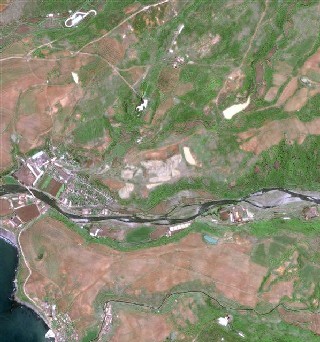hankyoreh
Links to other country sites 다른 나라 사이트 링크
[Analysis] Do N. Korea’s actions indicate impending missile test?

South Korea and the United States have stepped up their warnings against North Korea for what appear to have been preparations for a test-launch of its Taepodong-2 ballistic missile, focusing attention on whether the North will go through with the test and the motivations behind such a move.
In a recent unofficial briefing, South Korean government officials said they detected signs that the North were preparing to test-fire the missile, citing the movement of a vehicle carrying what is believed to have been the Taepodong-2, the longest range missile in the North’s arsenal. An official said, “The situation is similar to that in 2006, when North Korea last attempted a missile launch, given the departure and arrival locations.”
In early May of 2006, a U.S. military satellite took photo images of a trailer carrying the Taepodong-2 missile and its movement toward a missile experiment site in Musudan-ri, North Hamgyong Province. Before that, the missile had been moved by train from a munitions factory near Pyongyang to a train station in Gilju, North Hamgyong Province.
It takes some time for the North to fire the missile because it has to assemble the main body and its propellant, build a launch pad and inject liquid fuel. The North first test-launched the missile on July 5, 2006, about two months after signs of the missile movement were reported.
The recent movement of the missile to the Musudan-ri site was carried out in broad daylight using a train and trailer.
Observers say the North’s actions, which were easily detected by U.S. spy satellites, were carried out to put pressure on the U.S. government and prevent the U.S. administration of Barack Obama from excluding the nuclear issue from its policy agenda.
It is also possible that the North is timing its actions to a series of important events in February for maximum effect, observers say. The birthday of North Korean leader Kim Jong-il is Feb. 16, U.S. Secretary of State Hillary Rodham Clinton is scheduled to visit South Korea Feb. 19-20, and South Korean President Lee Myung-bak will mark the first anniversary of his inauguration on Feb. 25. “At this stage, it’s too early to guess about the timing of a missile launch. But North Korea seems to be choosing a time when its actions will have the greatest impact,” said one South Korean government official.
With regard to the time it will take for the North to execute a missile launch, the official said it was likely North Korea had corrected the errors that lead to the failed missile launch in 2006. The North “won’t need as much time as it did for the last launch,” the official said.
However, it remains uncertain whether the North will go through with the test, amid stern warnings by the United States.
Experts say that the launch date will be apparent, based on when the liquid fuel is siphoned into the missile’s engine. Because the fuel used by the missile is highly toxic and inflammatory, it can only be siphoned into the missile just before the missile is launched. Fuel injection take about a week.
When a missile launch is imminent, North Korea also sets up weather-forecasting radar and telemetry equipment to track the missile’s impact area. Related to this, the U.S. broadcaster CNN recently reported that North Korea appeared to have positioned the necessary telemetry equipment. However, because there is no evidence that precision radar has been positioned, it is believed that the North’s missile launch is not impending.
Please direct questions or comments to [englishhani@hani.co.kr]
Editorial・opinion
![[Column] Has Korea, too, crossed the Rubicon on China? [Column] Has Korea, too, crossed the Rubicon on China?](https://flexible.img.hani.co.kr/flexible/normal/500/300/imgdb/original/2024/0419/9317135153409185.jpg) [Column] Has Korea, too, crossed the Rubicon on China?
[Column] Has Korea, too, crossed the Rubicon on China?![[Correspondent’s column] In Japan’s alliance with US, echoes of its past alliances with UK [Correspondent’s column] In Japan’s alliance with US, echoes of its past alliances with UK](https://flexible.img.hani.co.kr/flexible/normal/500/300/imgdb/original/2024/0419/2317135166563519.jpg) [Correspondent’s column] In Japan’s alliance with US, echoes of its past alliances with UK
[Correspondent’s column] In Japan’s alliance with US, echoes of its past alliances with UK- [Editorial] Does Yoon think the Korean public is wrong?
- [Editorial] As it bolsters its alliance with US, Japan must be accountable for past
- [Guest essay] Amending the Constitution is Yoon’s key to leaving office in public’s good graces
- [Editorial] 10 years on, lessons of Sewol tragedy must never be forgotten
- [Column] A death blow to Korea’s prosecutor politics
- [Correspondent’s column] The US and the end of Japanese pacifism
- [Guest essay] How Korea turned its trainee doctors into monsters
- [Guest essay] As someone who helped forge Seoul-Moscow ties, their status today troubles me
Most viewed articles
- 1[Column] The clock is ticking for Korea’s first lady
- 2After 2 months of delayed, denied medical care, Koreans worry worst may be yet to come
- 3Hong Se-hwa, voice for tolerance whose memoir of exile touched a chord, dies at 76
- 4[Column] Has Korea, too, crossed the Rubicon on China?
- 5US overtakes China as Korea’s top export market, prompting trade sanction jitters
- 6Samsung barricades office as unionized workers strike for better conditions
- 7[Editorial] As it bolsters its alliance with US, Japan must be accountable for past
- 8[Correspondent’s column] In Japan’s alliance with US, echoes of its past alliances with UK
- 9All eyes on Xiaomi after it pulls off EV that Apple couldn’t
- 10[Correspondent’s column] The US and the end of Japanese pacifism